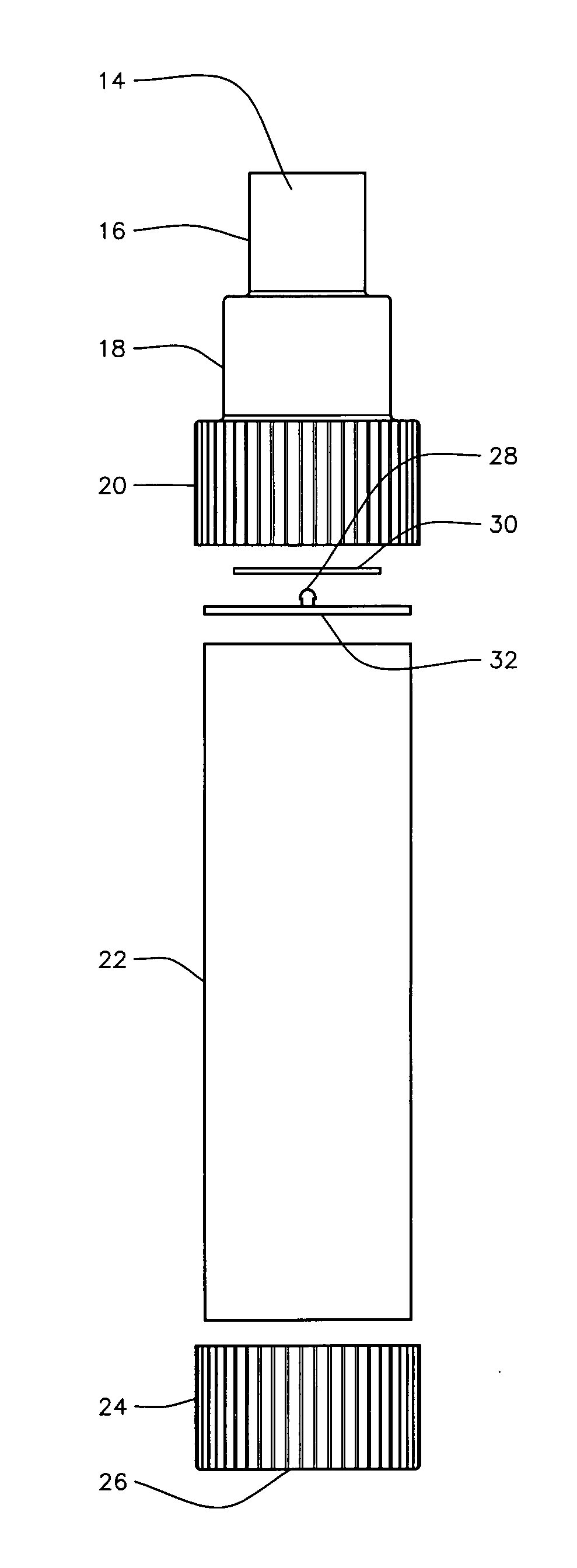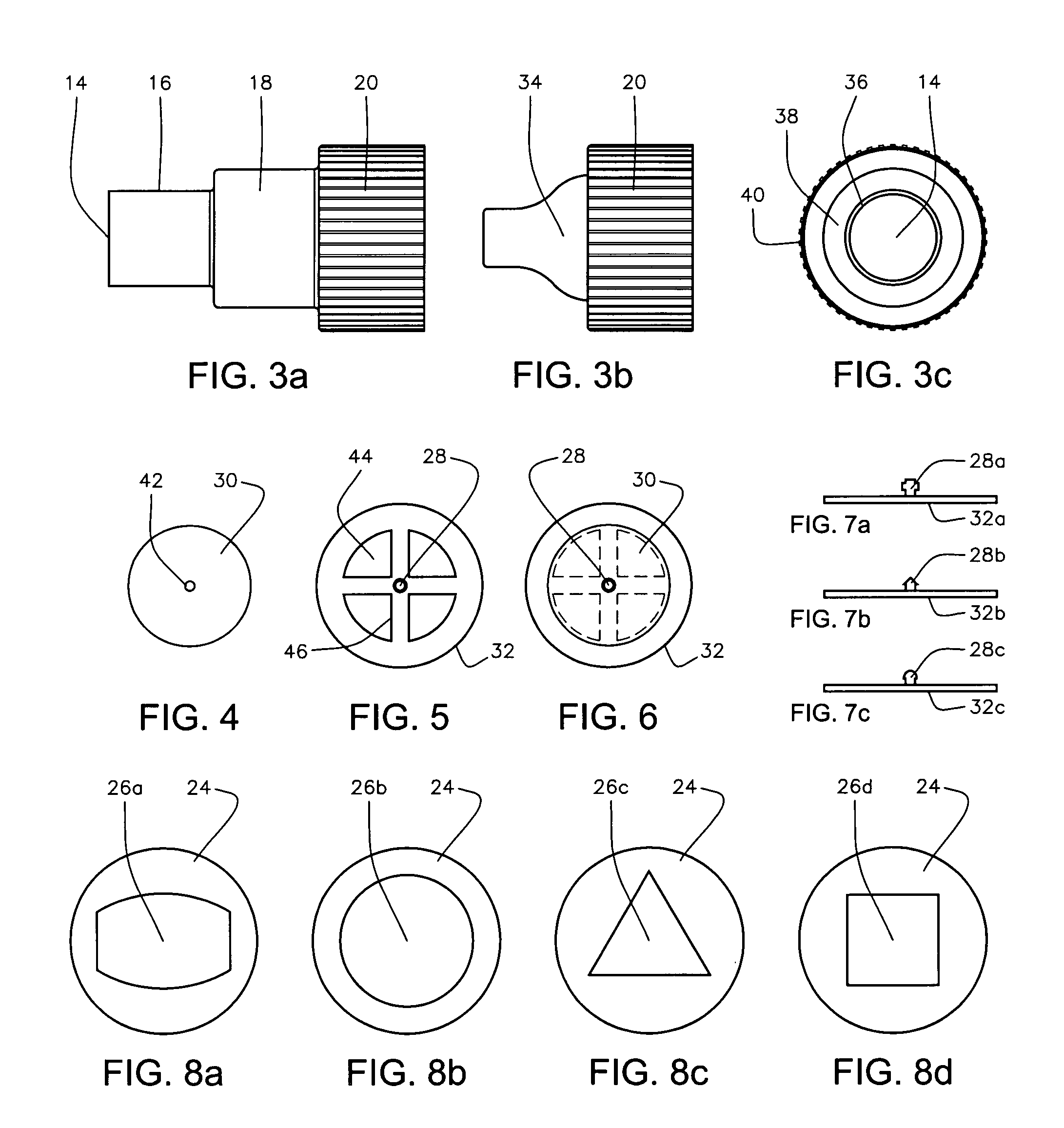However, the pMDI is very inefficient.
This results in a majority of the
drug being wasted and as a consequence, patients will constantly actuate more puffs from their pMDI's just to obtain relief.
This regrettably contributes to overdosing and brings unwanted systemic side effects like
tachycardia.
(a) Their average cost is around twenty dollars. Which is economically limiting for most patients who can just barely afford to pay for their medicines.
(b) Their confusing. Farmer's apparatus U.S. Pat. No. 6,494,202 offers technology that includes a full
mask, an expandable spring-loaded reservoir and an adjustable
exhalation valve, but its beyond the average patients understanding and ability to operate correctly.
(c) Their maintenance requirements. Each inhaled and exhaled warm breath offer
bacteria the perfect environment. The “Aerochamber” by the Monaghan Corporation comes with valves, whistles and available add-on accessories that offer many challenges for keeping viral microorganisms off. The exploded detail in U.S. Pat. No. 5,816,240 by Komesaroff reveals how daunting the task of spacer maintenance and cleaning is for the average patient.
(d) Their disposability is limited. U.S. Pat. No. 4,953,545 issued Sep. 4, 1990 to McCarty for a “Disposable Respiratory Medication Dispersion Chamber” is a spacer that cannot be discarded in part while sustaining the other parts for additional service thereby conserving resources.
(e) Their manufacture excludes two basic elements needed to perform effectively. Many publications including CHEST 1998:114:1676-1680 by Finley and Zuberbuhler pg. . . it is desirable to use holding chambers with valves that prevent rebreathing of the
exhaled air, otherwise little
drug will be inhaled from the
holding chamber” reveals the first important element as a one-way valve, which is a must have trend for spacers that specifically helps uncoordinated patients. The second needed element that is missing in McCarty's cited above and Sladek's U.S. Pat. No. 6,679,252 B2 is a chamber adequately spaced to provide a proper respirable flow. Sufficient spacing allows for time by distance to slow the propelled dispersion for better
aerosol delivery. Moreover, several “Second Generation” spacers including U.S. Pat. No. 5,477,849 issued Dec. 26, 1995 to Fry, fail to include either of these two much-needed elements.
(f) Their electrostatic properties.
Static cling is an inherent problem of the synthetic polymers used in their walls or in parts of their chambers. Most “Second Generation” spacers are plastic and electrostatic charge can build up on their surface walls. Compelling evidence collected shows the consequence of electrostatic charge on plastic devices to
aerosol drug retention within these devices, resulting in significant reduction of the medicine available for
inhalation. They demonstrate a
triboelectric effect, which is a type of
contact electrification in which certain materials become electrically charged after they come into contact such as through
rubbing with other material. “Historically, respiratory
drug delivery has disregarded the subject of
electrostatics” writes Professor Pert in “Relevance of
Electrostatics in Respiratory
Drug Delivery” and concludes: “that spacer electrostatic charge does influence drug retention in spacer devices and it would therefore seem obvious that manufacturers of spacer devices should use only non-electrostatic materials in the future”.
The current alternatives are limited to the premium non-static
metal spacers like the “Vortex” by the Pari Company or the expensive anti-static
polymer types like the “Aerochamber Max” by Monahan Medical Corp.
But their price is even more cost prohibitive to most patients.
Clearly, these “Second Generation” spacers have not explored materials having antistatic attributes that are less expensive to produce.
(g) Their lack of biodegradability.
Furthermore, the chemical additives like Stat-Ban® custom anti-static
polymer used in the Aerochamber Max that give plastic products desirable performance properties can have negative environmental and
human health effects.
A single resin type might be mixed with many such additives, adding complexity to the
chemical composition, possibly generating new classes of incompatible resins creating a recycling problem because blow-mold resin grades and injection-mold grades must be separated for primary recycling applications.
Such substances may be toxic.
It is readily apparent that this generation of spacers has not investigated renewable,
environmentally friendly embodiments that are easier and
safer to process for recycling.
(h) Their lack of adaptability.
Because of their set embodiments they cannot be transformed in place, or equipped by inexpensive modification for use by different pulmonary apparatus.
Not having a platform device that is adaptable to different pressurized medicinal applicators or even changeable to other pulmonary devices such as peak flow meters is problematic with the present generation of devices.
(i) Their lack of a replaceable valved
mouthpiece.
 Login to View More
Login to View More  Login to View More
Login to View More 


